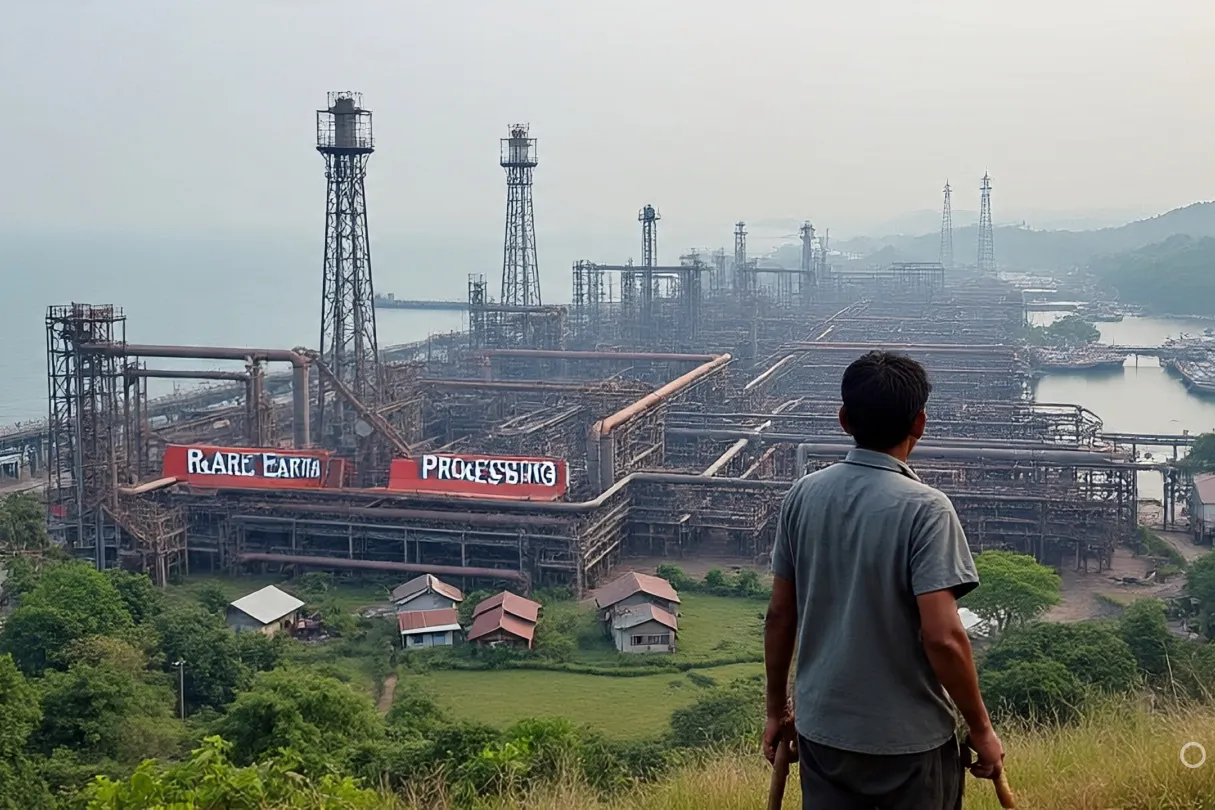⚙️ What are rare earths, and why Malaysia?
Rare earth elements (REEs) are a group of 17 metallic elements vital to modern technology—found in everything from smartphones and electric vehicles to military equipment and wind turbines. While rare in name, they’re actually plentiful but difficult to extract and refine without releasing toxic byproducts, including radioactive waste.
- ⚙️ What are rare earths, and why Malaysia?
- ☢️ Concerns from the ground: radiation, water, and waste
- 🛡️ What Lynas and the government say
- 📊 Comparing data: What science says
- 🕵️♀️ The cover-up theory: Politics, economics, and silence
- 🌱 Citizen science and the fight for accountability
- ⚖️ Between development and environmental justice
- 🧭 What the Lynas debate really reveals
In the early 2010s, Malaysia invited Lynas Corporation, an Australian mining company, to process rare earths in Kuantan, Pahang. The Lynas Advanced Materials Plant (LAMP) was positioned as a strategic move to establish Malaysia as a hub for high-tech industrial refinement while avoiding the environmental baggage of upstream mining.
But the choice raised immediate red flags. Processing rare earths creates radioactive residues, and critics questioned why a developing nation with limited environmental enforcement capacity was hosting such a facility when Australia refused to do so within its own borders.
☢️ Concerns from the ground: radiation, water, and waste
From its inception, the Lynas plant has faced opposition. Environmental activists, scientists, and residents have raised alarms over long-term exposure risks, especially given Malaysia’s history of lax enforcement and poor industrial transparency.
🧪 Key environmental concerns include:
- Radiation Exposure: The processing produces thorium waste, a radioactive byproduct that remains dangerous for thousands of years.
- Toxic Waste Management: Accusations persist that waste containment methods are temporary and leaky, especially during monsoon seasons.
- Groundwater Contamination: Leaks or runoff from storage areas risk contaminating local water supplies.
- Airborne Pollutants: Emissions from the plant could carry fine particulate matter harmful to respiratory health.
Local activist groups like Save Malaysia Stop Lynas (SMSL) have documented these concerns and submitted petitions to parliament, regulatory bodies, and even international agencies.
🎙️ Resident Testimony:
“We’re not anti-development. We just want to know why our kids are getting sick and whether this plant is safe. The government owes us answers,” said a resident of Balok, a village near the plant.
🛡️ What Lynas and the government say
Lynas has consistently defended the safety of its operations, pointing to multiple audits and inspections by third-party agencies. The company insists that its processes are within international safety limits and that waste is properly treated and stored.
🏢 Lynas’s official positions include:
- The thorium content in its residues is low and poses minimal health risk.
- Its residue storage is secure, monitored, and engineered to withstand local weather conditions.
- It maintains transparency and collaborates with Malaysia’s Atomic Energy Licensing Board (AELB).
The Malaysian government—under both Barisan Nasional and Pakatan Harapan coalitions—has maintained a mixed stance. While approving licenses and renewals, the government has also promised stricter oversight and even relocation of waste residue processing. Still, many argue these promises fall short of actual enforcement.
📑 Court cases and regulatory reviews have so far sided with Lynas, allowing continued operation. Critics argue that these reviews rely too heavily on data provided by Lynas and lack independent verification.
📊 Comparing data: What science says
To get a clearer picture, it helps to examine how rare earth processing has fared globally. China, which produces over 80% of the world’s rare earths, has faced devastating environmental costs—cancer clusters, contaminated rivers, and abandoned radioactive waste lakes.
🌐 Table: Rare Earth Processing Environmental Impact Comparison
| Country | Waste Management | Public Health Effects | Regulatory Oversight |
|---|---|---|---|
| China | Poor | High cancer rates near plants | Inconsistent |
| Australia | Strong | Minimal | Strict |
| Malaysia (Lynas) | Moderate (disputed) | Inconclusive (underreported) | Mixed/enforcement varies |
Malaysia’s lack of independent long-term studies makes it difficult to assess real public health effects. Critics argue that this absence of data is by design—not accident.
🕵️♀️ The cover-up theory: Politics, economics, and silence
One of the most persistent conspiracy theories is that Malaysian authorities, under pressure to attract foreign direct investment and appear industrially competitive, are intentionally suppressing data and criticism related to Lynas.
📌 Core claims of the theory:
- Lack of Transparency: Key environmental reports are unpublished or redacted.
- Political Pressure: Activists claim they’ve been harassed or silenced during protests.
- Foreign Lobbying: Rumors persist of diplomatic pressure from Australia and Japan to ensure Lynas remains operational.
- Media Blackouts: Independent media outlets report difficulty accessing plant data or interviewing officials.
Though hard evidence is scarce, leaked memos and whistleblower accounts from within regulatory agencies suggest that at least some monitoring data has been suppressed or not released to the public.
🌱 Citizen science and the fight for accountability
Faced with institutional inertia, many residents have turned to citizen science—collecting their own water samples, measuring background radiation with Geiger counters, and crowdsourcing health data.
📊 Some early results from local initiatives have shown elevated heavy metal levels in nearby rivers. While not conclusive, they raise enough concern to warrant deeper investigation.
📢 Activist-led pressure has also resulted in brief licensing suspensions and forced government responses. However, with every new administration, the intensity of oversight seems to shift.
⚖️ Between development and environmental justice
The Lynas issue sits at the crossroads of several critical debates in Malaysia:
- Is economic growth worth environmental risk?
- Can Malaysia ensure industrial safety without full transparency?
- What role should citizens play when official data is limited or withheld?
🔍 On one side are promises of jobs, international partnerships, and industrial prestige. On the other is a growing public unease rooted in historical neglect, distrust in regulatory bodies, and rising awareness of environmental justice.
🧭 What the Lynas debate really reveals
At its core, this isn’t just about one plant. It’s about how nations navigate the competing forces of economic ambition and ecological responsibility.
Lynas may very well operate within legal standards, but when those standards are not publicly scrutinized, people lose faith. The government’s reluctance to fully disclose inspection results, conduct independent studies, or engage meaningfully with local communities only deepens suspicion.
For now, Lynas continues its operations. But the debate it has sparked—about transparency, sovereignty, and citizen power—has only just begun.




